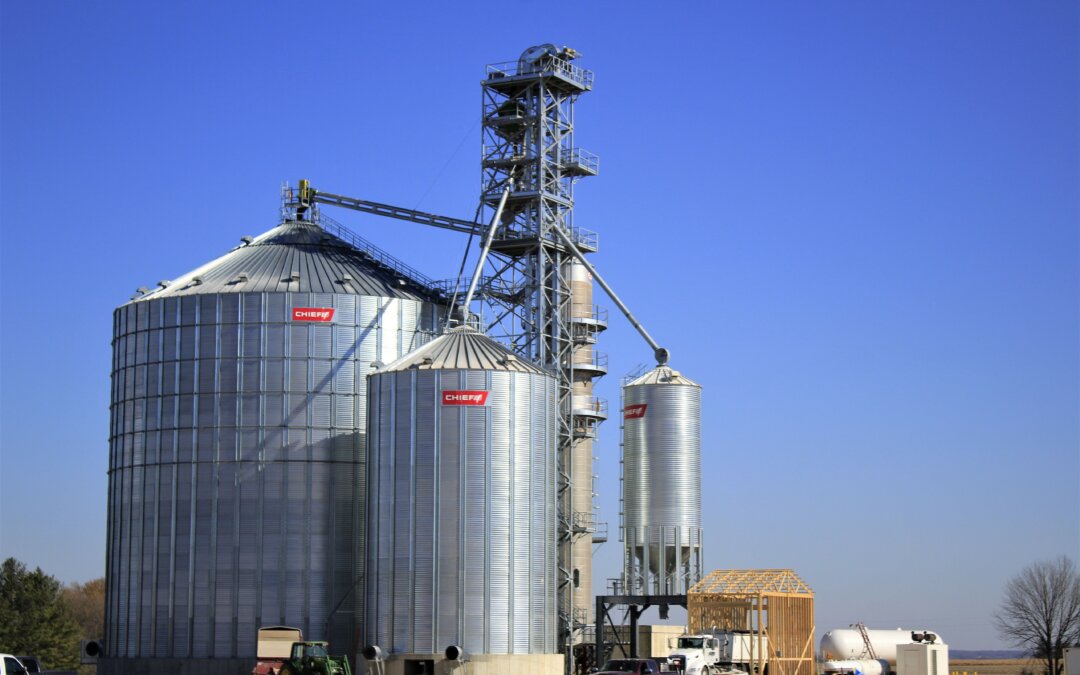Farming involves making big decisions that impact the nation’s food supply — one of which is grain storage. Wisely deciding when to store harvested grains can be a smart economic move, as prices typically increase over time.
Commercial grain elevators often pile their grain outside for temporary storage. Though this is initially an inexpensive investment, it leaves grain exposed to the elements and increases the possibility of spoilage. An alternative solution is renting permanent on-site storage at a commercial facility or another farm; although it’s an extra expense now, farmers are likely to see returns in saved bushels down the line.
For farmers wanting to retain control of their grain and ensure maximum protection from the elements, constructing a long-term storage facility on your farm is essential. Before you connect with your dealer to make a purchase, it’s critical to think through all the essential planning steps to ensure long-term success storing grain on your farm. Here’s some good advice as to why and how a farmer should store grain on their property.
Two key reasons for on-site storage
Jose Meza, Iowa district manager for Chief Agri, gives two primary reasons farmers decide to invest in an on-site grain storage facility. “The convenience of having a facility on the land they farm improves truck turnaround,” says Meza. “There’s nothing more frustrating for a farmer during harvest than having a combine sitting in the field waiting to be unloaded because the trucks can’t get back to the field fast enough,” he says.
The other reason is basic economics — supply and demand. A grain storage facility allows farmers to choose when and where to sell their grain based on their best market conditions.
Remember to plan for expansion
Meza emphasizes the necessity of long-term planning for grain storage. He often sees commercial elevators adding storage to current facilities as they transition from piling grain on the ground to a more secure storage system. “If they’ve traditionally been piling a million bushels of grain, they know storage for 1 million bushels will fill quickly, and they’re more likely to take that step towards building a larger storage facility,” says Meza, who acknowledges that kind of storage is something most farmers evolve into over the years.
Farmers typically know how much grain they might produce every year, but typically facilities are expanded over time. “Every year, new species and hybrids hit the market for better yields,” says Brent Whitefoot, Chief Agri’s district sales manager for Nebraska. “Whatever they think their capacity needs are today, they’re probably going to need more storage space in future years.” Whitefoot counsels farmers to consider the benefits of planning for a facility with a larger capacity than they think they need right away.
Both Meza and Whitefoot can recall examples of folks who’ve spent more money modifying poorly planned facilities than they would have if they had planned for a larger facility in the first place. And since Chief products are built to last, you can trust your Chief facility will serve you many years as you grow in your business and increase your yields.
Before you get started, consider these three tips:
1. Invest in quality equipment for the long term. While it can be tempting to cut corners and reduce your costs, remember that getting it right the first time is more cost-effective than being forced into changing it later.
2. Make sure you have a master plan. Just like your business plan for your farm allows for growth and change over the years, you should have a master plan in place for your buildings, including grain storage facilities. Knowing where you want to be 10 or 20 years from now will guide your decisions today, such as where you will build any new structures and additional handling equipment. The specialists at Chief Agri and Chief Agri’s dealers can help you develop a master plan to include grain storage facilities that incorporate space for a future truck load out system or bucket elevator.
3. Keep up on maintenance. A grain storage facility isn’t just a long-term investment for you; if you take care of it, it will last decades. “When the bin is empty, do your inspections and cleaning, and you will be able to pass it on to another generation,” says Meza.
Storage site considerations
With your master plan in hand, here are some considerations to ensure your facility will enhance your operations for years to come.
Water and weather. Examine your property to determine where water will flow and where it will run. Do you have drainage systems in place? How will they affect your grain storage facilities? Of course, keeping your driveways dry is critical. Another consideration is the weather. When it snows, where does the snow drift on your property?
“You don’t want to build too close to a shelterbelt to avoid snow drifts that could close access to your driveway and prohibit your semi from getting through in the wintertime,” says Whitefoot.
Overhead and underground utilities. Overhead power lines are a big concern when building your grain storage facility. Make sure your current building site and future expansion plans allow for proper clearance from power lines. Remember to check underground, too, and know before you dig. Consult a company that will mark utilities on your property to avoid expensive and potentially dangerous situations like building on top of a natural gas pipeline, for instance.
Room for augers, trucks and expansion. It’s worth repeating: Planning can save you giant headaches and expenses down the road. For example, your grain storage facility needs space beyond the concrete footprint on which it will sit. Think through truck traffic on your property — will loaded trucks have room to turn? Does your plan allow adequate space for augers? And if you expand in the future, ensure these elements still have the required space.
Airflow. One of the most critical planning elements to consider is airflow. Keeping grain at the right moisture content for long-term storage can be difficult — especially in large commercial facilities due to the sheer volume of grain — but proper airflow helps. “Regardless of what they build, you have to make sure it has adequate airflow,” says Whitefoot.
“I always tell people that if you design a system around 1/10 of cubic feet per minute per bushel, and if you put good quality grain in the bin at the proper moisture level, you can keep it there at 1/10 CFM,” says Whitefoot. “Poor quality grain or grain with higher moisture content needs more airflow to establish equilibrium to allow storage for several months.”
“But remember that more horsepower doesn’t always equate to more air,” says Meza.
Elevate your operations with Chief Agri
If you’re ready to elevate your operations with long-term grain storage facilities or if you’re unsure what type of grain storage facility is right for you, contact the folks at Chief Agri today. After all, they’ve been in the grain storage business for 60 plus years and know exactly what you need to consider.
Adding grain storage to your property is one of those big decisions that will significantly impact your operations. And if you do it right, it will benefit you and the next generation of farmers for years to come.
Sponsored content by Amy Carpenter-Driscoll, Brand Ave. Studios contributing writer

